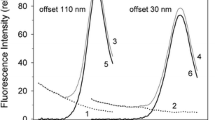Abstract
A number of vital cell functions including modulation of signaling pathways and regulation of the cellular transport critically depends on the cytoplasmic pH. Many pathological cellular changes are related to the abnormal cytosolic pH as well. Reliable and well-calibrated methods for quantification of the cytosolic pH are therefore of high importance. The pH calibration is particularly difficult in walled cells since standard methods fail. In this report we evaluated the new electroporative calibration method of the cytosolic pH in yeasts by the fluorescence microscopy. The calibration was done on living cells using pyranine as a ratiometric pH-sensitive probe. The probe was electroporatively delivered to the cytosol. We have shown that unlike the measurements in suspension the fluorescence microscopy reveals cell subpopulations with different sensitivity to the pH calibration. While the majority of the cells were well calibrated, there was found subpopulation of uncalibrated cell as well as singular cells exhibiting anomalous pH calibration due to the staining of acidic organelles. Resolution of cell subpopulations helps to achieve better pH calibration compared to the calibration in cuvette on a cell suspension.
Similar content being viewed by others
References
J. P. Bourdineaud (2000). At acidic pH, the diminished hypoxic expression of the SRP1/TIR1 yeast gene depends on the GPA2-cAMP and HOG pathways. Res. Microbiol. 151(1), 43–52.
S. H. Denison (2000). pH regulation of gene expression in fungi. Fungal. Genet. Biol. 29(2), 61–71.
A. J. Vriesema, J. Dankert, and S. A. Zaat (2000). A shift from oral to blood pH is a stimulus for adaptive gene expression of Streptococcus gordonii CH1 and induces protection against oxidative stress and enhanced bacterial growth by expression of msrA. Infect. Immun. 68(3), 1061–1068.
N. Altan, Y. Chen, M. Schindler, and S. M. Simon (1998). Defective acidification in human breast tumor cells and implications for chemotherapy. J. Exp. Med. 187(10), 1583–1598.
E. Crivellato, L. Candussio, A. M. Rosati, G. Decorti, F. B. Klugmann, and F. Mallardi (1999). Kinetics of doxorubicin handling in the LLC-PK1 kidney epithelial cell line is mediated by both vesicle formation and P-glycoprotein drug transport. Histochem. J. 31(10), 635–643.
S. Y. Chow, Y. C. Yen-Chow, and D. M. Woodbury (1992). Studies on pH regulatory mechanisms in cultured astrocytes of DBA and C57 mice. Epilepsia 33(5), 775–784.
J. W. Deitmer and C. R. Rose (1996). pH regulation and proton signalling by glial cells. Prog. Neurobiol. 48(2), 73–103.
H. J. Lin, P. Herman, and J. R. Lakowicz (2003). Fluorescence lifetime-resolved pH imaging of living cells. Cytometry Part A 52A(2), 77–89.
J. Slavik (1982). Intracellular pH of yeast cells measured with fluorescent probes. FEBS Lett. 140(1), 22–26.
W. Roos (2000). Ion mapping in plant cells–methods and applications in signal transduction research. Planta 210(3), 347–370.
A. Takahashi, P. Camacho, J. D. Lechleiter, and B. Herman (1999). Measurement of intracellular calcium. Physiol. Rev. 79(4), 1089–1125.
S. Y. Ho and G. S. Mittal (1996). Electroporation of cell membranes: A review. Crit. Rev. Biotechnol. 16(4), 349–362.
E. Neumann, S. Kakorin, and K. Toensing (1999). Fundamentals of electroporative delivery of drugs and genes. Bioelectrochem. Bioenerg. 48(1), 3–16.
A. Pena, J. Ramirez, G. Rosas, and M. Calahorra (1995). Proton pumping and the internal pH of yeast cells, measured with pyranine introduced by electroporation. J. Bacteriol. 177(4), 1017–1022.
B. C. Pressman (1976). Biological applications of ionophores. Annu. Rev. Biochem. 45, 501–530.
J. Vecer, A. Holoubek, and K. Sigler (2001). Fluorescence behavior of the pH-sensitive probe carboxy SNARF-1 in suspension of liposomes. J. Photochem. Photobiol. 74(1), 8–13.
R. Haworth, B. Lemire, D. Crandall, E. Cragoe, and L. Fliegel (1991). Characterisation of proton fluxes across the cytoplasmic membrane of the yeast Saccharomyces cerevisiae. Biochim. Biophys. Acta. 1098(1), 79–89.
M. Höfer, M. Calahorra, B. Klein, and A. Peńa (1996). Assessment of delta muH+ in Schizosaccharomyces pombe; intracellular inclusion of impermeable agents by electroporation. Folia Microbiol. (Praha) 41(1), 98–100.
M. Calahorra, G. Martínez, A. Hernández-Cruz, and A. Peńa (1998 Aprril 30). Influence of monovalent cations on yeast cytoplasmic and vacuolar pH. Yeast 14(6), 501–515.
J. Vecer, A. Holoubek, and P. Herman (2004). Manipulation of intracellular pH by electroporation: An alternative method for fast calibration of pH in living cells. Anal. Biochem. 329(2), 348–350.
J. Gehl and L. M. Mir (1999). Determination of optimal parameters for in vivo gene transfer by electroporation, using a rapid in vivo test for cell permeabilization. Biochem. Biophys. Res. Commun. 261(2), 377–380.
B. Gabriel and J. Teissie (1997). Direct observation in the millisecond time range of fluorescent molecule asymmetrical interaction with the electropermeabilized cell membrane. Biophy. J. 73(5), 2630–2637.
K. Kano and J. H. Fendler (1978). Pyranine as a sensitive pH probe for liposome interiors and surfaces. pH gradients across phospholipid vesicles. Biochim. Biophys. Acta. 509(2), 289–299.
Z. Darzynkiewicz, S. Bruno, G. Del Bino, W. Gorczyca, M. A. Hotz, P. Lassota, and F. Traganos (1992). Features of apoptotic cells measured by flow cytometry. Cytometry 13(8), 795–808.
O. S. Wolfbeis, E. Furlinger, H. Kroneis, and H. Marsoner (1983). Fluorimetric Analysis.1. A study on fluorescent indicators for measuring near neutral (Physiological) pH values. Fresenius Z. Für Anal. Chem. 314(2), 119–124.
K. A. Giuliano and R. J. Gillies (1987). Determination of intracellular pH of BALB/c-3T3 cells using the fluorescence of pyranine. Anal. Biochem. 167(2), 362–371.
P. S. Hair, K. H. Schoenbach, and E. S. Buescher (2003). Sub-microsecond, intense pulsed electric field applications to cells show specificity of effects. Bioelectrochemistry 61(1–2), 65–72.
J. Deng, K. H. Schoenbach, E. S. Buescher, P. S. Hair, P. M. Fox, and S. J. Beebe (2003). The effects of intense submicrosecond electrical pulses on cells. Biophy. J. 84(4), 2709–2714.
Author information
Authors and Affiliations
Corresponding author
Rights and permissions
About this article
Cite this article
Herman, P., Drapalova, H., Muzikova, R. et al. Electroporative Adjustment of pH in Living Yeast Cells: Ratiometric Fluorescence pH Imaging. J Fluoresc 15, 763–768 (2005). https://doi.org/10.1007/s10895-005-2985-5
Received:
Accepted:
Issue Date:
DOI: https://doi.org/10.1007/s10895-005-2985-5




